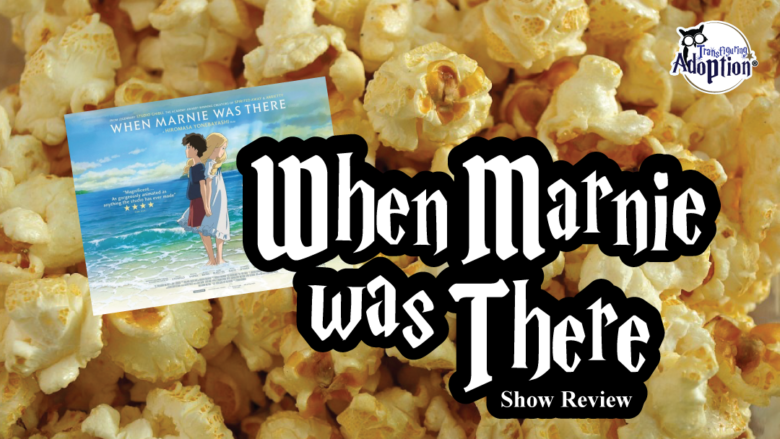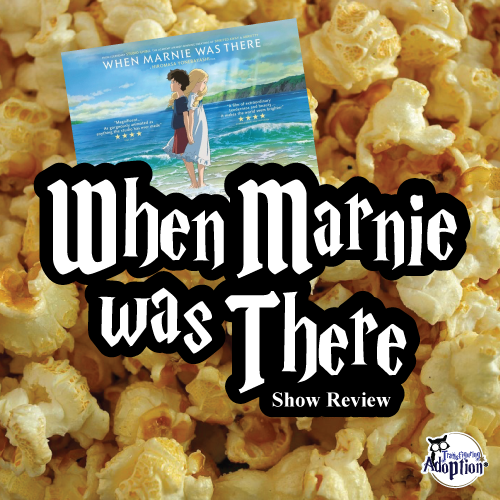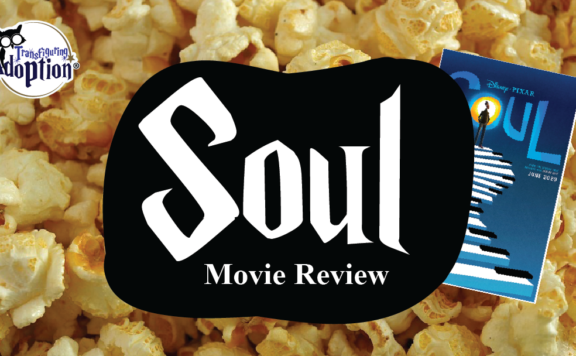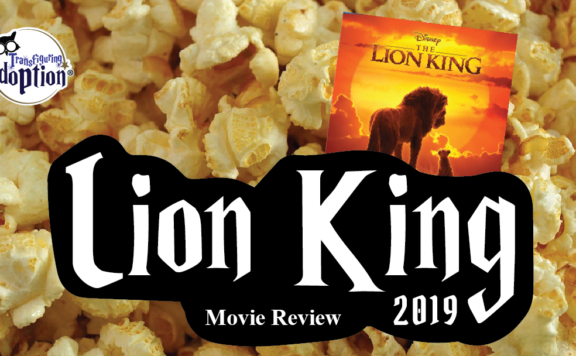Grade:
Transfiguring Adoption awarded this book 4 Hoots out of 5 based on how useful it will be for a foster/adoptive family. [Learn more about our Hoot grading system here]
Movie Info:
- Rating: PG – Thematic Elements and Smoking
- Genre: Animation, Drama
- Runtime: 103 minutes
- Studio: GKIDS/Studio Ghibli
From the Cover of When Marnie Was There by Studio Ghibli:
“From Japan’s famed Studio Ghibli comes a sweeping story of friendship, mystery, and discovery that delivers stirring emotions and breathtaking animation as only Studio Ghibli can. When shy, artistic Anna travels to the seaside to stay with relatives, she stumbles upon an old mansion surrounded by marshes, and the mysterious young girl, Marnie, who lives there. The two girls instantly form a unique connection and friendship that blurs the lines between fantasy and reality. As the days go by, a nearly magnetic pull draws Anna back to the Marsh House again and again, and she begins to piece together the truth surrounding her strange new friend. Based on the beloved young adult novel by Joan G. Robinson and directed by Hiromasa Tonebayashi (The Secret World of Arietty). When Marnie Was There is a haunting tale gorgeously rendered with its moonlit seascapes, flowing orchestral score, and powerful portrayals of friendship and belonging.”
Transfiguring Adoption’s Overview:
When Marnie Was There is rated PG, but the length and pace of the film may be best for an audience of ages eleven and up. It also appears this movie would be great for foster and adoptive families, though anyone could enjoy the beautiful storytelling, gorgeous artwork, and fantastic soundtrack. This movie might be relatable to foster and adoptive families due to the themes of identity as a foster/adoptive youth and a youth learning that “family” and “community” are more than biological bonds.
This movie can be a wonderful conversation starter for middle or high school-aged foster or adopted youth. The film does an excellent job of showing a youth wrestling with her identity as a foster child, within the foster family, and within the surrounding community. These years for children and teens in general are filled with identity building in general, but having the added cultural element which foster care youth from the child welfare system often experience adds levels of stress unique to this culture.
** Spoilers Could Be Ahead **
How Is This Relevant To Adoption & Foster Care?
Anna, the main character, is a twelve-year old girl in Japan. She lives with her long-time foster family which includes a foster mother (who is shown in the film) and a foster father (who frequently travels for work). Anna is introduced in the beginning as a loner, describing herself as “outside of the circle.” This is evident in how she stays physically distant from everyone from her fellow classmates to her foster mother. Anna is shown to have psychosomatic responses (meaning, physical symptoms in response to stress) in response to her shifting moods and loneliness. Throughout the film Anna is slowly able to connect her feelings to her behaviors and build a support network from the children and adults she meets while she spends her summer in the countryside.
This film can be a fantastic resource to teach the relationship between the mind and the body and the impact of stress. Children and youth exposed to trauma often do not think through the stress response and simply just react. By slowing down and practicing awareness with body, mind, and soul, Anna is able to move forward and develop positive communication and relationships with others. It is crucial for children and youth in foster care to develop external supports and develop interpersonal skills as seen in the film. Anna’s perspective as she sorts through these hard thoughts and feelings can be beneficial for caregivers who wish to see and understand foster youth’s perspectives of such challenges.
Discussion Points:
- Communicating Anxiety
Children very seldom say, “I am anxious.” Children will often say, “My tummy hurts.” This is because the mind and body are very closely connected. When watching the movie, pay attention to how Anna responds physically after stressful or emotional interactions. - Foster Child Identity
While foster parents understand that the stipend provided by the state or federal agencies are strictly reimbursements, children and youth may not be aware that these stipends exist and that they are not income. Foster care as a culture has several points that are very different from the culture of an established or biological child in the home, including agency/government involvement. Foster parents should be mindful about the best way to address aspects like this in foster care and how a foster child or youth could “fill in the blanks” if they have not been explained in age appropriate terms what some of these differences mean. - Community Supports
Anna learns through the course of the movie that while she may not have direct connections to living blood relatives, she very much can build supports outside of her foster family. Anna spends the summer with her foster mother’s relatives and overtime builds relationships with other children in the area. Anna starts the film stating that she is “outside” the circle, but by the end of the film has gravitated to the center of a circle of support, better equipped for life with her newfound sense of identity and security. Foster children and youth very much benefit from supports outside of foster care as these bonds can last even after exiting foster care.
Cautionary Points:
- Foster Care Specific Triggers
Anna discovers her foster parents receive a board payment for caring for her. This adds to her sense of feeling alone and different. Anna processes emotions concerning this throughout the film. This could potentially trigger concerns about this in children or youth if left unaddressed. - Supervision Concerns
Throughout the film, Anna is permitted to wander about the new town with little to no supervision at age twelve. It is not advised that foster children or youth be permitted to traverse across towns unsupervised, especially if there are safety concerns already in place due to runaway/elopement. - Biological Family Trauma
Anna eventually connects to her biological family through fantasy-based mediums. Children often wonder about and long for their families (whether known or not) when in foster care, and this could be stressful for children who have been separated from the family from the home of origin. - Displays of Physical/Emotional Abuse
Marnie discloses to Anna that when her parents go out of town (frequently) she is often beaten and threatened by the household staff. A major plot point concerns Marnie being threatened by the staff members to be locked into a dark silo. Children or youth in foster care may have experienced instances of physical or emotional abuse, and caregivers should be mindful that children or youth may take years to discuss instances of abuse. - Displays Adult Characters Smoking
A few characters in the film smoke. - Traumatic Events
When Marnie’s past is revealed, there are depictions and references to physical/emotional abuse, psychiatric commitment, familial conflict, and a fatal car crash. These themes may be triggering to children or youth who have dealt with these issues.
Discussion Guide:
- Who was your favorite character in the movie? Why?
Caregiver Note: This is meant to be an ice breaker. Though this movie ended on a positive note, it is filled with some heavy emotions. Children and youth may need a minute to focus on some positive aspects first before discussing potentially traumatic content. - Who did you most relate to in the movie? Why?
Caregiver Note: Most children and youth will probably relate to either Anna or Marnie, though some of the side characters may come up. Feel free to discuss if you related to any characters: child or adult. Practice being open and honest with your children and youth, and this will encourage them to engage as well. - Why do you think Anna seems to get sick after talking to her teacher about her art work? What was happening when Anna got sick during other parts of the film?
Caregiver Note: This is a great discussion point to discuss making mind and body connections. Humans experience physical symptoms in response to various levels of stress. However, children and youth have to be taught introspective skills to read these physical signs and connect them to their feelings. Give them an example of how you may experience stress. For example, when having this discussion with my daughter, we discussed getting butterflies in the tummy when excited and tummy aches when wanting to avoid something unpleasant. I also discussed getting headaches during testing when I was younger and having muscle tension as an adult when conflict arose at work. - ACTIVITY – Middle School Ages: Take some butcher paper and draw an outline of your child’s body. Have them use different colors and color/draw where on their bodies they “feel” emotions.
Caregiver Note: This can be an activity for any age, but younger children benefit from a visual while discussing psychosomatic symptoms of stress and depression. High schoolers may prefer to color an outline on a regular-sized sheet without getting on the floor. - Have you ever felt “different” because of being in foster care or being adopted? In what ways?
Caregiver Note: Some children or youth will have various responses to this. Some may discuss having workers come to their school while others may discuss having more limitations to social activities than non-foster youth. While state/agency policies must be adhered to, it is important to listen to our children and youth and be mindful of ways we can reduce the impact of foster care on normalcy. - How could Anna’s foster family have better helped support her while she explored her sense of identity?
Caregiver Note: Some children and youth may need this question to be fleshed out. Responses can be concerning her foster parents or the relatives Anna spent the summer with. Some children may feel that the space Anna was given to process was needed while others may express wanting more connection due to how alone Anna feels. Children and youth may begin to speak to their own experiences and may feel more comfortable this way talking about how they would want to be supported during a hard time, which will help with communication and expectations in the future with your own family. - Throughout the film Anna slowly made several friends outside of her relationship with Marnie. Some of these friends were younger, some older, and some were her peers. How could having relationships with people of different ages be a strength? Or a challenge?
Caregiver Note: Foster children and youth lose every protective and supportive relationship when brought into care: pets, neighborhood friends, aunties/uncles, clubs, youth group leaders, school mates, teachers, and sometimes even siblings. Foster youth especially need connections of all sorts while in foster care to become successful young adults. Though several state/federal/private agencies offer extension of foster care services, when a youth ages out of foster care participation in such programs are not compulsory. Foster youth benefit from having trusted adults (in addition to peers) in their lives to help them process life decisions without having all supports tied to the welfare system. These supports can (of course) include their foster parents, but just as foster and adoptive parents need a strong support system outside of the child welfare system, so do foster youth. - Activity: Treasure Map of Resources. Take a piece of paper and draw a small circle, a larger circle around that, and then separate small circles surrounding the center circles. Have the child or youth write their name in the very center. Have the child or youth assign all supportive persons in their household (including pets) in the center with the child’s name. Then have other supportive people listed in the bigger circle around the smaller group. After this have the child or youth list supports, clubs, churches, sports, etc. that help them in the smaller circles on the outside. Help your child or youth determine how strong/weak these outer supports are in helping them succeed.
Caregiver Note: This is a great activity to help children or youth visualize their current supports whether they be physical, emotional, financial, etc. By helping attach strengths too and showing how they orbit the child or youth, they can better identify supports that may be needed or need to be strengthened. - How can I help you expand your circle? How can I help you feel like a part of your circle?Caregiver Note: Like Anna, many youth may feel like they are excluded from a circle and not realize they are the center. Having a frank conversation on how you can help your child integrate in your family and in other supportive circles may bring about solutions not explored before. The aim regardless is to find connection so that the child or youth does not feel alone and has a place to run to in times of stress.
- Are there any questions you have for me as your foster parent relating to foster care?
Caregiver Note: This question can open the door to discuss any topics the child or youth may be afraid to discuss. It’s important to be open and honest while still being mindful of the child’s developmental state. If you have questions about what is appropriate to discuss concerning stipends, safety plans, state/federal policies, etc., you may want to discuss them with your state/federal/private agency worker first. However, children or youth tend to fill in gaps of information with their imaginations, much like how Anna assumed her foster parents were caring for her for monetary gain when discovering her foster parents receive a stipend for her care.
Buy From Our Links and Support Transfiguring Adoption:
Transfiguring Adoption is a nonprofit organization seeking to nurture growth in foster and adoptive families by giving a HOOT about their families. Transfiguring Adoption does not intend for its reviewers nor its review to be professional, medical or legal advice. These reviews and discussion guides are intended to help parents to better be able to connect and understand their children who come from traumatic backgrounds.







